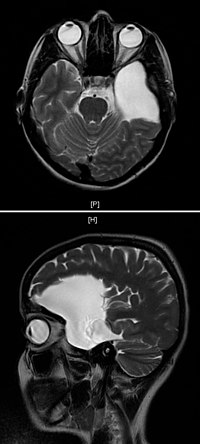
Photo from wikipedia
OBJECTIVE Colloid cysts of the third ventricle are histologically benign lesions that can cause obstructive hydrocephalus and death. Historically, colloid cysts have been removed by open microsurgical approaches. More recently,… Click to show full abstract
OBJECTIVE Colloid cysts of the third ventricle are histologically benign lesions that can cause obstructive hydrocephalus and death. Historically, colloid cysts have been removed by open microsurgical approaches. More recently, minimally invasive endoscopic and port-based techniques have offered decreased complications and length of stay, with improved patient satisfaction. METHODS A single-center retrospective analysis of patients with colloid cysts who underwent surgery at a large tertiary care hospital was performed. The cohort was assessed based on the surgical approach, comparing endoscopic resection to open microsurgical resection. The primary endpoint was rate of perioperative complications. Univariate analysis was used to assess several procedure-related variables and the cost of treatment. Multivariate analysis was used to assess predictors of perioperative complications. Total inpatient cost for each case was extracted from the health system financial database. RESULTS The study included 78 patients with colloid cysts who underwent resection either via an endoscopic approach (n = 33) or through a craniotomy (n = 45) with an interhemispheric-transcallosal or transcortical-transventricular approach. Nearly all patients were symptomatic, and half had obstructive hydrocephalus. Endoscopic resection was associated with reduced operative time (3.2 vs 4.9 hours, p < 0.001); lower complication rate (6.1% vs 33.1%, p = 0.009); reduced length of stay (4.1 vs 8.9 days, p < 0.001); and improved discharge to home (100% vs 75.6%, p = 0.008) compared to microsurgical resection. Coagulated residual cyst wall remnants were more common after endoscopic resection (63.6% vs 19.0%, p < 0.001) although this was not associated with a significantly increased rate of reoperation for recurrence. The mean follow-up was longer in the microsurgical resection group (3.1 vs 4.9 years, p = 0.016). The total inpatient cost of endoscopic resection was, on average, one-half (47%) that of microsurgical resection. When complications were encountered, the total inpatient cost of microsurgical resection was 4 times greater than that of endoscopic resection where no major complications were observed. The increased cost-effectiveness of endoscopic resection remained during reoperation. CONCLUSIONS Endoscopic resection of colloid cysts of the third ventricle offers a significant reduction in perioperative complications when compared to microsurgical resection. Endoscopic resection optimizes nearly all procedure-related variables compared to microsurgical resection, and reduces total inpatient cost by > 50%. However, endoscopic resection is associated with a significantly increased likelihood of residual coagulated cyst wall remnants that could increase the rate of reoperation for recurrence. Taken together, endoscopic resection represents a safe and effective minimally invasive approach for removal of colloid cysts.
Journal Title: Journal of neurosurgery
Year Published: 2022
Link to full text (if available)
Share on Social Media: Sign Up to like & get
recommendations!